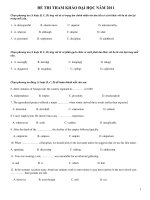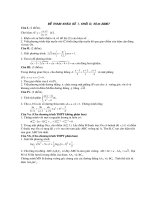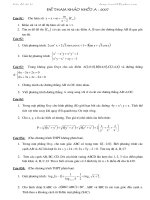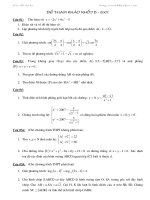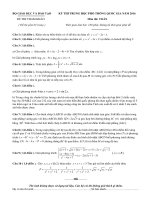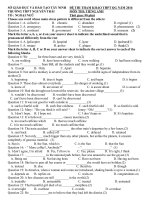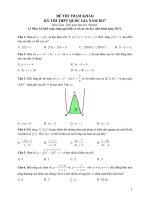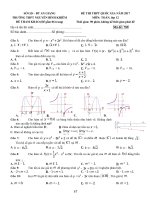- Trang chủ >>
- THPT Quốc Gia >>
- Ngoại Ngữ
ĐỀ THI THAM KHẢO THPT QG năm 2016 THPT NGUYỄN TRÃI docx
Bạn đang xem bản rút gọn của tài liệu. Xem và tải ngay bản đầy đủ của tài liệu tại đây (129.93 KB, 7 trang )
SỞ GIÁO DỤC VÀ ĐÀO TẠO TÂY NINH ĐỀ THI THAM KHẢO THPT QG NĂM 2016
TRƯỜNG THPT NGUYỄN TRÃI
MÔN THI: TIẾNG ANH
TỔ : NGOẠI NGỮ
Thời gian: 90 phút
Choose one word whose main stress pattern is different from the others:
Question 1: A. collective
B. climatic
C. abundant
D. regional (1)
Question 2: A. emergency
B. concentration
C. humanity
D. phenomenon (2)
Question 3: A. continent
B. government
C. reference
D. museum (2)
Mark the letter a, b, c, or d on your answer sheet to indicate the underlined sound that is
pronounced differently from the rest
Question 4. A. helicopter
B. hospital
C. hour
D. husband(1)
Question 5. A. money
B. notice
C. glance
D. thank(2)
Mark the letter A, B, C or D on your answer sheet to indicate the correct answer to each of the
following blanks.
Question 6: We _____ for three hours and are very tired.(2)
A. are walking
B. have been walking
C. were walking
D. had been walking
Question 7: ___________ from Bill, all the students said they would go.(1)
A. Except
B. Only
C. Apart
D. Separate
Question 8: Not until a monkey is several years old _________to exhibit signs of independence from its
mother.(2)
A. beginning
B. does it begin
C. and begin
D. it begins
Question 9: These days almost everybody ________the danger of smoking.(1)
A. know of
B. are aware of
C. is aware about
D. is aware of
Question 10: Had the drought not lowered the reservoir, the ancient village__________(3)
A. wouldn't be discovered
B. wouldn't have been discovered
C. can't have been discovered D. can't be discovered
Question 11: It was not good to walk outside in ___________.(3)
A. such a fearful cold
B. such fear coldness
C. such fearful cold
D. so fearful a cold
Question 12: Mary: “Do you think it will rain? “
Jenny: “Oh! ________”(1)
A. I don’t hope. B. I hope not.
C. I don’t hope so
D. It’s hopeless
Question 13: It is believed _____________ causes insomnia.(2)
A. too much caffeine which
B. that too much caffeine
C. it in too much caffeine
D. too much caffeine that
Question 14: The train accident _____________ the other train’s departure by a few hours.(2)
A. sent back
B. called off
C. delayed
D. retained
Question 15: Not only____ much bigger than any other planets, but unlike the planets, it consists
completely of gaseous material. (3)
A. Sun is
B. the Sun, which is
C. is the Sun
D. that the Sun
Question 16: - “ More coffee?, Anybody?”
- “ _________________.” (1)
A. I don’t agree, I’m afraid B. Yes, I’d love to
C. Yes, please
D. It’s right, I think
Question 17: . ____________ to the national park before, Sue was amazed to see the geyser.(3)
A. Being not
B. Not having been
C. Have not been
D. Having not been
Question 18: She has to pass all her exams or _____________she would have no holiday.(2)
A. instead
B. else
C. therefore
D. though
Question 19: In America, when a woman and a man are introduced, shaking hands is up to a woman.(1)
A. depends on
B. replies on
C. waits on
D. congratulates on
Question 20: A few diseases are still _________in the world.(2)
A. treatable
B. untreatable
C. treated
D. untreated
Question 21: That beautiful girl died of an ________morphine.(2)
A. overweight
B. overhear
C. overdo
D. overdose
Question 22: He ____________me to believe that they had left the district.(2)
A. made
B. led
C. assured
D. confirmed
Question 23: He was completely ___________by her tale of hardship.
(3)
A. taken away
B. taken down
C. taken in
D. taken up
Question 24: Uncle Ho’s desire was that our country might ______other countries in the world. (2)
A. be fed up with
B. make use of
C. keep pace with D. take grand for
Question 25: Sarah is a young girl with________ and a straight nose.(2)
A. almond-shaped eyes B. almond-eyed shape C. eyes shaped almond
D. almond-shape eyed
Question 26: You shouldn't ___________ to your teacher like that. It was very rude.(2)
A. have talked
B. talk
C. have be talked
D. talked
Question 27: Don’t bother me while I___________.(2)
A. am working
B. was working
C. will work
D. will have completed
Question 28: Oh, no! My wallet has been ____________(1)
A. robbed
B. picked
C. stolen
D. theft
Question 29:A: There's someone at the door
B: ________________it.(1)
A. I'm answering
B. I answer
C. I'll answer
D. I answered
Read the following passage and mark the letter A, B, C ,or D on your answer sheet to indicate the
correct answer to each of the questions from 30 to 39.
The White House, the official home of the United States president, was not built in time for
George Washington to live in it. It was begun in 1792 and was ready for its first inhabitants. President
and Mrs.John Adams, who moved in on November 1, 1800. When the Adams moved in, the White
House was not yet complete, and the Adams suffered many inconveniences; for example, the main
staircase was incomplete, which hindered movement from floor to floor, and the future laundry yard was
merely a pool of mud, so wet laundry was hung in the unfinished East Room to dry. Thomas Jefferson,
the third president, improved the comfort of the White House in many respects and added new
architectural features such as the terraces on the east and west ends.
When the British forces burned the White House on August 24, 1814, President Madison was
forced to leave. All the remained after the fire was the exterior walls, the interior was completely
destroyed. It was not until December of 1817 that the following president, James Monroe, was able to
move into a rebuilt residence. Since then, the White House has continued to be modified but has been
continuously occupied by each succeeding U.S president.
Question 30: Which of the following would be the most appropriate title for this text?(3t)
A. George Washington’s life in the White House.
B. The Early History of the White House.
C. The burning of the White House.
D. Presidential Policies of Early U.S. Presidents.
Question 31: Why did George Washington not live in the White House?(1)
A. It had been burned by the British.
B. He did not like the architectural features.
C. He did not want to suffer the inconveniences that the Adams had suffered.
D. Construction had not yet been completed.
Question 32: The word “inhabitant” in line 2 is closest meaning to____.(1)
A. modifications
B. moves
C. celebrations
D. residents
Question 33: It can be inferred from the passage that John Adams was_____.(3T)
A. the first president of the United States.
B. the second president of the United States.
C. the third president of the United States.
D. the fourth president of the United States.
Question 34: What of the White House was not yet complete when the Adams moved in?(2)
A. main staircase B. kitchen
C. pool
D. window
Question 35: The author most likely discusses the “staircase” in line 5 in order to____.(2)
A. show the elegance of the new White House
B. explain the architectural features added by Jefferson.
C. provide an example of an inconvenience in the White House.
D. demonstrate what had to be rebuilt after the fire.
Question 36: The word “forces” in line 9 could best be replaced by(1)
A. military
B. effort
C. power
D. energy
Question 37: According to the passage, which of the following best describes Thomas Jefferson’s tenure
in the White House?
A. He worked to improve the appearance and convenience of the White House.(1)
B. He had to flee the White House because of the war with the British.
C. He removed the terraces that had been added by Adams.
D. He was accepting of the many inconveniences.
Question 38:According to the passage, when James Monroe came to the White House, it had been____.
(1)
A. repressed
B. reconstructed
C. relocated
D. reserved
Question 39: The paragraph following the passage most likely discusses____.(3t)
A. the details of the destruction of the White House by the British.
B. James Monroe’s policies as presidents.
C. modifications by presidents who followed.
D. other presidents who were unable to occupy the White House.
Mark the letter A, B, C, or D on your answer sheet to show the underlined part that needs
correction.
Question 40: A paragraph is a portion of a text consists of one or more sentences related to the same idea.
(3t)
A
B
C
D
Question 41:Chemical engineering is based on the principles of physics, chemists, and mathematics.(3t)
A
B
C
D
Question 42: I hadn’t understood his directions. However, I asked him to repeat what he’d said.(3t)
A
B
C
D
Mark the letter A, B, C, or D on your answer sheet to indicate the word or phrase that is closest in
meaning to the underlined part in each of the following questions.
Question 43: You ought to send two hours as a minimum in the fresh air every day.(3t)
A. at most
B. at all
C. at least
D. at ease
Question 44: In most countries, compulsory military service does not apply to women.(3t)
A. superior
B. mandatory
C. benificial
D. constructive
Read the following passage and mark the letter A, B, C, or D on your answer sheet to indicate the
correct answer to each of the questions from 45 to 54.
ENVIRONMENTAL ACTIVISTS
Paul Watson is an environmental activist. He is a man who believes that he must do something,
not just talk about doing something. Paul believes in protecting endangered animals, and he protects
them in controversial ways. Some people think that Watson is a hero and admire him very much. Other
people think that he is a criminal.
On July 16th, 1979, Paul Watson and his crew were on his ship, which is called the Sea Shepherd.
Watson and the people who work on the Sea Shepherd were hunting on the Atlantic Ocean near Portugal.
However, they had a strange prey; instead of hunting for animals, their prey was a ship, the Sierra. The
Sea Shepherd found the Sierra, ran into it and sank it. As a result, the Sierra never returned to the sea.
The Sea Shepherd, on the other hand, returned to its home in Canada. Paul Watson and his workers
thought that they had been successful.
The Sierra had been a whaling ship, which had operated illegally. The captain and the crew of the
Sierra did not obey any of the international laws that restrict whaling. Instead, they killed as many
whales as they could, quickly cut off the meat, and froze it. Later, they sold the whale meat in countries
where it is eaten.
Paul Watson tried to persuade the international whaling commission to stop the Sierra. However,
the commission did very little, and Paul became impatient. He decided to stop the Sierra and other
whaling ships in any way that he could. He offered to pay $25,000 to anyone who sank any illegal
whaling ship, and he sank the Sierra. He acted because he believes that the whales must be protected.
Still, he acted without the approval of the government; therefore, his actions were controversial.
Paul Watson is not the only environmental activist. Other men and women are also fighting to
protect the Earth. Like Watson, they do not always have the approval of their governments, and like
Watson, they have become impatient. Yet, because of their concern for the environment, they will act to
protect it.
Question 45: According to the reading, an environmental activist is someone who ____(1)
A. runs into whaling ship
B. does something to protect the Earth
C. talks about protecting endangered species
D. is a hero, like Paul Watson
Question 46: When something is controversial, ____(1)
A. everyone agrees with it
B. everyone disagrees with it
C. people have different ideas about it
D. people protect it
Question 47: The members of a ship’s crew are ____.(1)
A. the men and women who work on the ship
B. the people who work on the airplanes
C. all of the people on a ship, including the passengers
D. the people who own the ship
Question 48: The main idea of paragraph one is that ____.(3t)
A. Paul Watson is a hero to some people
B. activists are people who do something
C. Paul Watson is a controversial environmental activist D. Paul Watson does not believe in talking
Question 49: The Sea Shepherd was hunting ____(2)
A. the Atlantic Ocean B. whales
C. the Sierra
D. Portugal
Question 50: The author implies that Paul Watson lives in ____(3t)
A. Portugal
B. a ship on the Atlantic
C. the Sierra
D. Canada
Question 51: The captain and the crew of the Sierra were acting illegally because ____.(1)
A. they were not obeying international laws
B. they were whaling
C. they were killing and selling whales
D. All of the above are correct
Question 52: In paragraph 3 the phrase “and froze it” refers to ____.(1)
A. whale meat
B. the Sierra
C. whales
D. the Sierra crew
Question 53: The main idea of paragraph 3 is that ____ .(3t)
A. the Sierra sold whale meat in some countries
B. the people on the Sierra didn’t obey international laws.
C. the people on the Sierra killed as many whales as they could.
D. whaling is illegal according to international law.
Question 54: Watson ran into the Sierra because ____ .(2)
A. he wanted to stop the ship’s crew from whaling
B. he was patient with the government’s actions
C. he didn’t want to protect the whales from the whalers
D. he acted with the approval of the government
Read the following passage and mark the letter A, B ,C, or D on your answer sheet to indicate the
correct word for each of the blanks
Face-to-face conversation is two-way process: You speak to me, I reply to you and so on. Two-way
(55)___depends on having a coding system that is understood by both (56)___ and receiver, and an agreed
convention about (57)____ the beginning and end of the (58) ___. In speech, the coding system is the
language like English or Spanish; the convention that one person speaks at a time may seem too obvious to
(59)____. In fact, the (60)___ that people use in conversations and meetings are often non-verbal. For
example, lowering the pitch of the voice may mean the end of a sentence; a sharp intake of breath may
signal the desire to (61)____, catching the chairman’s (62)___may indicate the desire to speak in a formal
setting like a (63)___, a clenched fist may indicate anger. When these (64)___ signals are not possible,
more formal signals may be needed.
Question 55: A. interchange
B. exchange
C. correspondence D. communication(1)
Question 56: A. announcer
B. transmitter
C. messenger
D. sender(1)
Question 57: A. signing
B. symbolizing
C. signaling
D. showing(2)
Question 58: A. message
B. topic
C. idea
D. theme(2)
Question 59: A. judge
B. mention
C. recognize
D. notice(2)
Question 60: A. signals
B. symptoms
C. symbols
D. signs(1)
Question 61: A. interchange
B. interfere
C. interrupt
D. intercept(2)
Question 62: A. elbow
B. eye
C. shoulder
D. hand(1)
Question 63: A. chat
B. debate
C. broadcast
D. lecture(1)
Question 64: A. visual
B. auditory
C. verbal
D. sensory(2)
WRITING
I.
PART 1: Finish each of the following sentences in such a way that it mean the same as the
sentence printed before it.
Question 1: It is believed that the man escaped in a stolen car.(3c)
The man………………………………………………………………………………………..
Question 2: We started working for this company seven years ago.(3c)
We have………………………………………………………………………………………..
Question 3: No body in my class is more intelligent than Mark.(3c)
Mark……………………………………………………………………………………………
Question 4: The test was very difficult. We couldn’t do it.(3c)
The test was so…………………………………………………………………………………
Question 5: But for your help, I couldn’t have finished my project.(3c)
Had…………………………………………………………………………………………….
II.
In about 140 words, write a paragraph about the kind of job you would like to do after
you finish your education. (3c)
Keys:
Question 1: The man is believed to have escaped in a stolen car.
Question 2: We have been working/ have worked for this company for seven years.
Question 3: Mark is the most intelligent (student) in my class.
Question 4: The test was so difficult that we couldn’t do it.
Question 5: Had you not helped me, I couldn’t have finished my project.
Questio
n
1
2
3
4
5
6
7
8
9
10
11
12
13
Đáp án
D
B
D
C
D
B
C
B
D
B
C
B
B
Questio
n
17
18
19
20
21
22
23
24
25
26
27
28
29
Đáp án
B
B
A
B
D
B
C
C
A
A
A
C
C
Questio
n
33
34
35
36
37
38
39
40
41
42
43
44
45
Đáp án
B
A
C
A
A
B
C
B
C
B
C
B
B
Questio
n
49
50
51
52
53
54
55
56
57
58
59
60
61
Đáp án
C
D
D
A
B
A
D
D
C
A
B
A
C
14
15
16
1.
2.
3.
4.
5.
C
C
C
30
31
32
B
D
D
46
47
48
C
A
C
62
63
64
Mô tả tiêu chí đánh giá
Bố cục
• Câu đề dẫn chủ đề mạch lạc
• Bố cục hợp lí rõ ràng phù hợp yêu cầu của đề bài
• Bố cục uyển chuyển từ mở bài đến kết luận
Điểm tối đa
0,40
Phát triển ý
• Phát triển ý có trình tự logic
• Có dẫn chứng, ví dụ, … đủ để bảo vệ ý kiến của mình
Sử dụng ngôn từ
• Sử dụng ngôn từ phù hợp với nội dung
• Sử dụng ngôn từ đúng văn phong/ thể loại
• Sử dụng từ nối các ý cho bài viết uyển chuyển
Nội dung
• Đủ thuyết phụ người đọc
• Đủ dẫn chứng, ví dụ, lập luận
• Độ dài: Số từ không nhiều hơn hoặc ít hơn so với quy định 5%
0,25
Ngữ pháp, dấu câu và chính tả
• Sử dụng đúng dấu câu
• Chính tả: Viết đúng chính tả
*Lỗi chính tả gây hiểu nhầm / sai lệch ý sẽ bị tính một lỗi (trừ 1% điểm bài viết)
* Cùng một lỗi chính tả lặp lại chỉ tính là một lỗi
• Sử dụng đúng thời, thể, cấu trúc câu đúng ngữ pháp. Lỗi ngữ pháp gây hiểu nhầm / sai
lệch ý sẽ bị tính một lỗi (trừ 1% điểm bài viết)
0,25
Tổng
1,50
0,30
0,30
KHUNG MA TRẬN ĐỀ THAM KHẢO TNQG –LỚP:12 -2015-2016
(Dùng cho loại đề kiểm tra TNKQ và Tự luận))
Chủ đề (nội dung, chương
Vận dụng
Nhận biết
Thông hiểu
trình)
Cấp độ thấp
Cấp độ cao
TNK
TNK
TL
TNKQ
TL
TNKQ
TL
TL
Q
Q
Ngữ
Pronunciation
2
3
âm
Từ
Vocabulary
-Biết
vựng
từ
đồng
nghĩa
4
-giới
từ
4
Ngữ
Grammar
Biết
5
pháp
về
cấu
Hiểu về cấu
trúc
trúc câu
8
Giao
tiếp
B
B
A
Speaking
3
Cộng
0.625
1.0
1.625
0.375
Sửa lỗi
Đồng
nghĩa
Đọc
hiểu
Correcting
mistakes
Synomy
3
-Reading
Cloze-test
6
-Answer
Viết
Tổng
cộng
0.625
2
5
10
1.25
5
4
2.5
Writing
Sentenc
e
transfor
mation
5 câu
24
24
16
5
- Viết 1 đoạn văn
ít nhất 140 từ về
chủ đề của
chương trình 12
0,5
1,5
10
